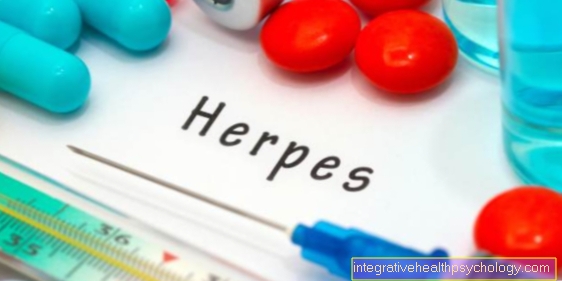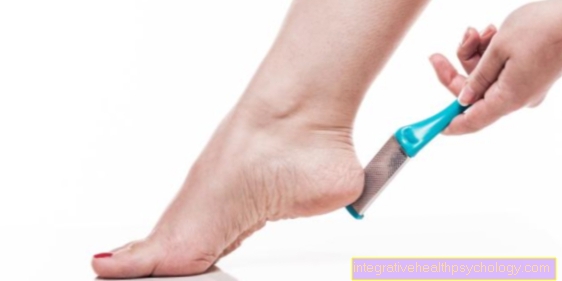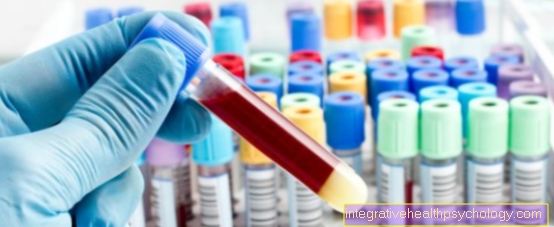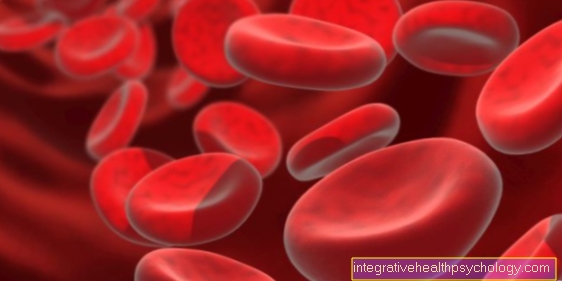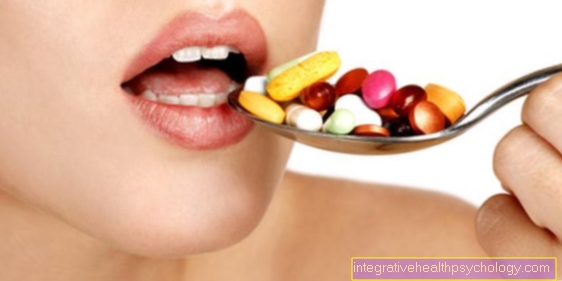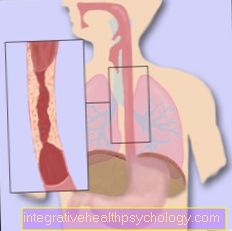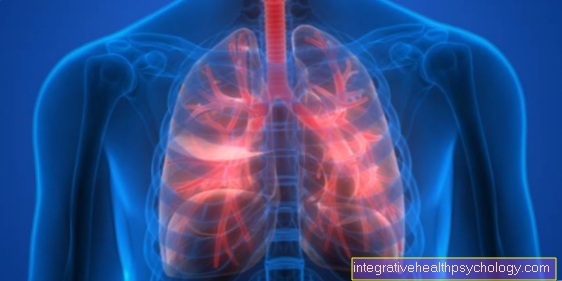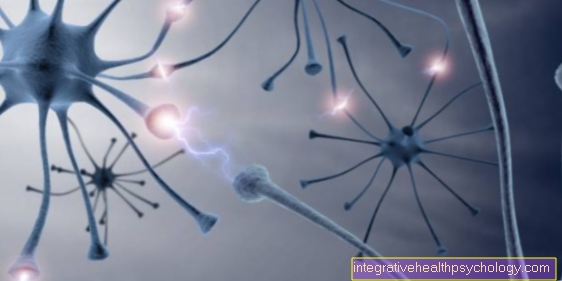Marcumar®
Synonyms in a broader sense
- Phenprocoumon (active ingredient name)
- Coumarins
- Vitamin K antagonists (inhibitors)
- Anticoagulants
- Anticoagulants
Explanation / definition of Marcumar®
Marcumar® belongs to the group of indirectly acting inhibitors of blood coagulation (medical: indirect anticoagulants). In contrast to direct anticoagulants such as heparin, which directly affects blood clotting, the mechanism of action of coumarins is to inhibit the formation of blood clotting factors necessary for clotting (see below).
Its effect was discovered by chance in Canada: In the 1920s, it was proven that the increased incidence of severe, often fatal bleeding in cattle and sheep was due to their consumption of rotting clover, which contained large amounts of the coumarin dicoumarol produced during fermentation .
The disease, previously feared as Sweet Clover Disease, made it possible to treat the first patients with dicoumarol just a few years later and has been recommended since 1944 for preventive treatment after a heart attack.

Trade names
Marcumar®
Chemical name
Phenprocoumon
application areas

Marcumar® is used, among others, for the following clinical pictures:
- thrombosis
- Pulmonary embolism
- Atrial fibrillation
- artificial heart valves
- Heart attack prophylaxis
Coumarine / Marcumar® are used to treat clots in the leg veins (thrombosis) and pulmonary embolism.
A pulmonary embolism occurs when a clot in the leg veins breaks free, enters the pulmonary artery via the inferior vena cava, atrium, and chamber of the right heart, and blocks the vessel. This can e.g. after long immobility such as air travel or after operations with subsequent bed restraint.
Typical symptoms of pulmonary embolism, which is 10% fatal within the first hour, include:
- Sudden shortness of breath (medical: dyspnea) or accelerated breathing (Tachypnea)
- sharp pain in the chest (thorax)
- and characteristic changes in the blood count (so-called D-dimers, which are fragments of the body's own protein fibrin, are detectable in the blood in 95% of all embolisms. The D-dimers arise as a natural defense reaction of the body against excessive blood clotting that leads to clot formation.
In severe cases of pulmonary embolism (so-called "brilliant"Pulmonary embolism" can also lead to a sudden drop in blood pressure with dizziness or loss of consciousness:
The right heart, which is responsible for the blood supply to the lungs, tries to pump blood into the lungs against the increased resistance caused by the clogging clot in the downstream vessel, but as a pump designed for low pressures is overwhelmed and becomes insufficient.
For more information on pulmonary embolism, see our topic: Pulmonary Embolism
The importance of the coumarins / Marcumar® taken as Marcumar® tablets (medicinally: orally) in the treatment of pulmonary embolism is primarily the prevention of further pulmonary embolisms.
The mechanism consists in the inhibition of the formation of the blood coagulation factors II, VII, IX, and X, which are necessary for blood clotting.
The enzyme necessary for the production (protein) is irreversibly (irreversibly) inactivated by Marcumar®.
Enzymes are biological catalysts that accelerate chemical reactions in the body. The task of the enzyme inhibited by Marcumar® is to accelerate the regeneration of vitamin K, which is required for the synthesis of the above-mentioned blood coagulation factors and is "consumed" in the process.
For those interested in chemistry
The Vitamin K - Vitamin K alkoxide derivative enables carboxylation, i.e. the accumulation of CO2 on glutamate residues of the blood coagulation factors, by binding a proton.
A lack of vitamin K (the K stands for "coagulation", medically for "blood clotting") has the same effect as taking Coumarins.
In return, the Anticoagulant be stopped at any time by taking vitamin K (e.g. if bleeding occurs as an undesirable side effect, see below), as this is then available again for the synthesis of the blood clotting factors. The coagulation is improved by the administration of Marcumar® again within a few hours.
To dissolve existing clots (thrombosis) are not coumarins / marcumar®, but so-called Fibrinolytics displayed. These are enzymes that break down the fibrin formed as part of the clotting reaction.
Examples of such fibrinolytics administered acutely in the intensive care unit as a first measure are urokinase, alteplase and streptokinase obtained from bacteria.
Coumarins / Marcumar® are also used to prevent clot formation in atrial fibrillation (VHF) used.
With this most frequent persistent, 80% without symptoms occurring Cardiac arrhythmia, the atria contract up to 400 times per minute, which leads to insufficient ejection capacity into the ventricles and, as a result, to a slowdown in blood flow (medical: stasis) and increased risk of clot formation (thrombosis) is coming.
The reason for this is that the shear forces of the flowing blood stimulate the vessel walls to release the body's own anticoagulant substances.
If there is no stimulation, a vaso-occlusive thrombus forms. The anticoagulants formed by intact vessel walls, such as nitric oxide (NO), can also be administered therapeutically to treat a Angina pectoris attack To widen the coronary arteries (angina pectoris means "chest tightness" in medical terms) and describes the feeling of oppression in the chest caused by a lack of oxygen supply to the heart.
The reason for this is almost always an as coronary heart desease, short CHD, called atherosclerosis the Coronary arteries, i.e. the storage of fat particles in the vascular wall, which causes inflammation with the immigration of immune cells and the release of vascular-damaging substances.
The deposits in the vessel reduce its diameter so much that sufficient blood to supply the heart muscle can no longer flow through it.
For the treatment of this disease, which is mainly caused by high blood cholesterol levels, cigarette smoking and high blood pressure, in addition to the aforementioned NO, see above. furthermore so-called Beta blockers available, which reduce the need for oxygen by lowering the heart rate and the strength of the heart.
In addition, beta-blockers lengthen, for example the drugs that are often administered Metoprolol and Bisoprolol (Trade names: Belok zok® or also bisoprolol) which prolong the relaxation phase of the heart known as diastole, in which the coronary vessels passively fill with oxygen-rich blood after a contraction of the subsequently slacking heart muscle.
Improve this way Beta blockers the oxygen supply to the heart not only by reducing the need, but also by increasing the oxygen supply.) Studies with many patients have shown that Coumarine / Marcumar® in the long term improve the prognosis with existing coronary heart disease, as the anticoagulant prevents e.g. Complete closure of the coronary arteries and death of heart muscle cells occurs (heart attack).
Even after operations with Replacement of heart valves such anticoagulation is necessary because artificial heart valves as exogenous materials activate the coagulation system more intensely, even if attempts are made to minimize this risk by using new materials coated with anticoagulant substances. Another application of coumarins / marcumar® provides the Avoiding relapses (medical: relapse prevention) after Heart attacks represent.
effect
Medically known as hemostasis Blood clotting represents a highly complex, cascade-like reaction in the blood vessel, in which the mutually activating blood coagulation factors ultimately activate an enzyme called thrombin, which splits off small fragments from the giant protein fibrinogen (also known as blood coagulation factor II), which the blood platelets (medical: Platelets) network with each other and thus form a stable blood clot.
The formation of the The main clotting enzyme thrombin either from the outside ("extrinsic") in the case of vascular damage, which leads to the exposure of connective tissue fibers (collagen), through toxins formed by bacteria ("endotoxins"), or activation takes place through substances released into the blood vessel from the inside ("intrinsic") .
In any case, the blood coagulation factors only work optimally when various accompanying substances, membrane fats and electrically positively charged substances are added calcium available.
The latter is required so that the coagulation factors can attach to negatively charged surfaces of the blood platelets and network them in a stable manner.
The necessary presence of calcium is used therapeutically to make blood incoagulable by removing calcium (e.g. so that blood does not clot immediately when blood is drawn, molecules called citrate or EDTA are added, which bind the calcium present in the blood so that it no longer occurs is available for blood clotting.)
Metabolism of the coumarins
What happens to coumarins in the body (medical: pharmacokinetics)?
The two main used Coumarins are that with one Duration of action from 7 to 10 days longer-acting phenprocoumon (better known by its trade name Marcumar®) and that which inhibits coagulation for up to 6 days Warfarin (better known als Coumadin).
Coumarins are the first anticoagulant drugs that are available as tablets, i.e. orally, as they are almost completely absorbed from the intestine, like other nutrients, into the blood (medical: reabsorbed) and are not destroyed by the hydrochloric acid in the stomach.
It should be noted that the maximum effect of the Coumarine / Marcumar® does not occur immediately, but only after 24 to 36 hours, since only the formation of new coagulation factors is inhibited, but the factors still present in the blood are not broken down.
Anticoagulants / anticoagulants that are effective immediately must therefore be administered at the start of therapy.
Usually will Heparin used, which directly inhibits the main blood coagulation enzyme, thrombin (as well as blood coagulation factor X).
On the contrary, the coumarin administration initially even leads to increased blood clotting, which makes the additional administration of heparin necessary: Coumarins also inhibit the formation of anticoagulant proteins, which "Protein C" and "Protein S" to be named.
If these “natural thrombosis protection substances” are no longer sufficiently formed, the very undesirable effect threatens - namely, increased clot formation.
Side effects
Marcumar is a drug that prevents the formation of certain proteins called clotting factors. The coagulation factors are usually responsible for the blood cells to stick together. For example, wounds can be closed in the event of bleeding. If the blood cells cling too tightly together, this can lead to small blood clots called blood clots. Since these vessels can clog and thus trigger heart attacks and strokes, Marcumar is used for prevention. However, this inhibits the body's natural mechanism to stop bleeding. This results in frequent side effects such as lengthy bruises that occur even after minor injuries, increased nosebleeds or bleeding gums.
Blood can also be found in the urine. These side effects occur in more than 10% of people who take Marcumar. Due to the increased risk of bleeding, bleeding can also occur as side effects in many other organ systems, muscles and joints. The gastrointestinal system is also affected in 1-10% of cases. Bleeding in these areas may show up as vomiting with blood, blood in your stool, or black stools. In the event of these abnormalities, a doctor should be consulted as soon as possible. Whether there is an acute open source of bleeding can then be clarified with a gastroscopy or colonoscopy. The open area is then closed directly.
The pericardium and retina can also be affected. There is a risk of cardiac arrest or blindness. Very dangerous bleeding can also occur in the spinal cord or brain. If bleeding occurs, the leaked blood can crush nerves. These then lose their functions, such as guiding sensations. In addition, the following areas in the brain are no longer properly supplied with blood. If this is the case, one speaks of a bleeding (hemorrhagic) stroke.
Furthermore, due to the accumulation of small bleeds, anemia occurs in rare cases as a side effect of Marcumar. It manifests itself in the form of fatigue and a drop in performance. In order to prevent these side effects, it is very important that the dosage is precisely adapted to the respective patient and is constantly checked.
Another very rare side effect that occurs is skin death. This happens at the beginning of the therapy and is a side effect that initially appears paradoxical. Marcumar needs a few days to sufficiently prevent the formation of the coagulation factors. However, to a very small extent, it also inhibits proteins that dissolve blood clots. For this reason, until the effects are fully effective, more and more clots form, which clog small vessels in the skin. The following areas are no longer supplied with blood and die. To prevent this, an additional anticoagulant drug is often taken at the beginning of Marcumar therapy.
More information on this topic: Side effects of Marcumar
Another very rare side effect that occurs is skin death. This happens at the beginning of the therapy and is a side effect that initially appears paradoxical. Marcumar needs a few days to sufficiently prevent the formation of the coagulation factors. However, to a very small extent, it also inhibits proteins that dissolve blood clots. For this reason, until the effects are fully effective, more and more clots form, which clog small vessels in the skin. The following areas are no longer supplied with blood and die. To prevent this, an additional anticoagulant drug is often taken at the beginning of Marcumar therapy.
More information on this topic: Side effects of Marcumar
Interactions
Other medicines, such as heparin, which also work to prevent blood clots, can increase the effectiveness of marcumar. As a result, the risk of bleeding is also increased. In addition, drugs that reduce the breakdown of Marcumar also increase its effectiveness. These can be statins, various antibiotics such as amoxicillin or anabolic steroids, for example.
Other drugs bring about the increased breakdown of marcumar and thus reduce the anticoagulant. These are barbiturates, rifampicin, diuretics, metformin or substances that contain vitamin K. In order to be able to control the interaction with other drugs, frequent blood clotting tests should be carried out. But Marcumar can also influence other drugs. When taken at the same time, it increases the effect of sulfonylureas, a drug that is used to lower blood sugar in type 2 diabetes mellitus. This means there is a risk of hypoglycemia, i.e. low blood sugar.
Contraindications
Marcumar must not be taken if there is an allergy to the active ingredient phenprocoumon. Even if you are hypersensitive to similar drugs from the same group, i.e. the so-called coumarin derivatives, the intake should be avoided. In addition, pregnancy is another contraindication for the use of Marcumar. Furthermore, therapy with Marcumar should not take place if there is an illness that increases the risk of bleeding. These can be, for example, severe liver or kidney damage, stomach ulcers or inflammation in which the heart is affected.
Read more about this: When should Marcumar not be given?
dosage
The active substance Phenprocoumon, known under the drug name Marcumar®, is a popularly "blood thinning“Drug and belongs to the group of Coumarins (Vitamin K antagonists). "Blood thinning“Does not mean that there is a thinning of the blood, but that the blood clotting is inhibited to reduce the risk of a Thrombus formation to reduce. A thrombus is a clot of blood that can lead to a stroke or heart attack.
The attending physician draws up a plan for the dosage of Marcumar, which is given to each patient individually is adapted. At the beginning of each treatment, the so-called thromboplastin time of the patient must first be determined. This is measured in seconds, but in percent (Quickwert) or as a whole number (INR value) specified. With their help, a statement can be made about the body's own coagulation system. It must be measured and checked at regular intervals throughout the course of treatment.
The dosage of Marcumar® is adjusted according to the thromboplastin time. Nowadays it should be specified as INR value (INR = International Normalized Ratio). It is determined worldwide in a standardized procedure and is used to determine coagulation. A normal INR value is 1. Depending on the disease, the therapeutic range usually includes values of around 2 to 4.5. This includes the area that offers the best possible protection against clots, but also presents the lowest risk of bleeding.
Read more about the topic here: INR
Of the Quick value is also a laboratory parameter that allows a statement to be made about the function and disorders of the coagulation system. Its normal range is between 70 and 120%. However, it can turn out differently from laboratory to laboratory due to different reagents and has therefore been replaced by the standardized INR value mentioned above. In general, ever lower the INR value is, the more shorter is the clotting time. A shorter blood clotting time means the risk of thrombosis increases. The other way around speaks a higher INR value for a extended Clotting time and thus for a higher Bleeding tendency. For example, an INR of 2 means that the clotting time is twice as long as normal. The Quick value behaves completely opposite to the INR. That means high Quick value = short clotting time, low Quick value = long clotting time. Anticoagulant substances, including Marcumar as explained above® counts, increase the INR value and thus reduce the risk of thrombus formation.
As the liver produces larger amounts of Vitamin K stores, continues the action of Marcumar® not immediately, but needs a few days to fully develop. The patient must therefore also overlap for an immediate effect Heparin treated until the respective target value / range is reached.
Marcumar® will be at the beginning of treatment very high dose (approx. 2-4 tablets of 3mg each) to build up an effective level. As a result, the INR value rises sharply in the first few days (even to values above 3). A high INR value usually indicates a reduced ability to clot. However, the high INR values in the first few days of taking the medication only simulate this. One reason for this is the different dismantling times of the individual Clotting factors. With so-called factor VII the half-life is approx. 5-6 hours, with the more important factor II it is 40-60 hours. If you look at these hours, you can see that there is almost only an increased conversion of factor VII in the first day. Therefore, it takes some time before you can rely on the INR values for the ability to clot. It is also important to start taking Marcumar® the values can still fluctuate a great deal, so regular check-ups are extremely important in order to reduce both the risk of bleeding and the risk of thrombus formation.
After the initially high doses, the daily dose is slowly reduced until the INR levels off in its therapeutic range for the respective disease. At a deep one Leg vein thrombosis or Atrial fibrillation the target range is between 2 and 3. With one mechanical heart valve it is then a bit higher, namely 3 to 4.5. So the doctor has to adjust the daily dosage individually for each patient and taking into account the disease present while checking the values.
Initially, the coagulation values are determined Every day, after a certain time and when the values no longer fluctuate as much weekly and at some point only once a month. Each patient receives a so-called "Marcumar®-Passport“That he should always carry with him. This contains the measured INR values and the corresponding dosage of his tablets as well as the disease that led to the therapy. If the value is now in the therapeutic range, the Marcumar is® Dosage around 1 tablet (3mg) per day.
Ingestion
Treatment with Marcumar® takes place in Tablet form. You should be with if possible a lot of fluids and whole be taken. The intake should if possible not with the food take place, as the effect can be weakened here. It should always be done at about the same time of day, for the sake of simplicity in the evening.
With a diet above a Nasogastric tube must be kept at least 2 hours away from the meal, since otherwise there is also a weakened to a complete loss of the Marcumar®-Effect can come.
Because Marcumar® a Opponent of vitamin K you should be careful not to consume too much vitamin K in your diet. Certain foods contain a lot of it. These should not be avoided, but you should be careful not to consume them in large quantities (e.g. Brussels sprouts, broccoli, asparagus, etc.).
When taking / dosage of Marcumar® it should also be noted that there is a surgery usually has to be discontinued. This should be discussed with the attending physician or the surgeon beforehand. The Marcumar® must then go through accordingly Heparin syringes be replaced. Until the coagulation after stopping Marcumar® normalized, it usually takes 7-10 days. If there is a risk of massive bleeding, for example during an emergency procedure, vitamin K or coagulation concentrates can be given to "buffer". During one pregnancy allowed Marcumar®should not be ingested as it may harm the unborn child.
nutrition
The drug Marcumar®, its active ingredient Phenprocoumon is called, is an anticoagulant. It intervenes in the blood coagulation process to inhibit it.
During coagulation, a long chain of activation processes takes place in the body. The individual coagulation factors activate each other. The Vitamin K-dependent factors II, VII, IX, X are essential here. They also play a major role Coagulation Modulators Protein C and Protein Sthat are also vitamin K dependent.
With Marcumar® these factors cannot be activated or only to a very small extent and the coagulation is suppressed. For some diseases, such as deep vein thrombosis, atrial fibrillation or an artificial heart valve, taking Marcumar® is essential. In simple terms, one can say that Marcumar® is the antagonist of vitamin K. Vitamin K is urgently needed in order to be able to produce the above-mentioned coagulation factors.
Humans take in vitamin K with their food. It is mainly found in green vegetables such as spinach. In addition, the body's own intestinal bacteria are able to produce vitamin K. Vitamin K is absorbed with the help of bile acids, as it is a fat-soluble vitamin. The daily requirement for vitamin K is around 65 micrograms for women and at 80 micrograms for men. A deficiency or an excess of vitamin K is observed very rarely in healthy people. However, patients with Marcumar® must be strictly controlled INR area The aim is to be very precisely informed about the influenceability of food containing vitamin K, the interactions with other drugs and the effect of alcohol on Marcumar®.
Since Marcumar®, as already mentioned, represents the antagonist to vitamin K, it is important to pay attention to foods that contain a lot of vitamin K when dieting under Marcumar® therapy. These foods can weaken or even cancel the effect of Marcumar®. The rule here is that the tablets should not be taken with food, as this can already reduce the effect. The Marcumar® tablets should always be taken at the same time and whole, in order not to forget them on the one hand and to ensure a constant medication level on the other. It is recommended to take the tablets in the evening.
It is neither necessary nor sensible to completely change your own diet when taking Marcumar® by avoiding all products that contain vitamin K. However, you should not eat a lot of foods that contain high amounts of vitamin K several times a day. In addition, foods that contain large amounts of vitamin K should be consumed as evenly as possible throughout the day in order to prevent fluctuations in the vitamin K level.
Foods that contain a lot of vitamin K include, for example, various types of vegetables such as broccoli, some types of cabbage or asparagus. 100 grams of broccoli contain around 154 micrograms and 100 grams of asparagus around 40 micrograms of vitamin K. A top value among foods containing vitamin K is kale with around 250 micrograms of vitamin K per 100 grams.
With meat, caution should be exercised, especially with offal, pork or very fatty beef. Eggs and dairy products also contain higher amounts of vitamin K. Meat loaf turns out to be very rich in vitamin K in animal products with 70 micrograms per 100 grams of meat.
As you can see from these examples alone, it is very difficult to do without these foods in everyday life. A complete waiver is not necessary and also not advisable. It is important to have a varied and varied diet, which is recommended to everyone and therefore also to Marcumar® patients. Foods with a lower vitamin K content are, for example:
- Apples
- pineapple
- bun
- Pearl barley
- or trout.
There are a number of tables for nutrition at Marcumar®, in which you can see the respective vitamin K content. It may be necessary in everyday life to change the daily dosage of the drug by taking more Marcumar®. During the asparagus season, for example, when some patients eat more asparagus, it may be necessary to increase the dose of Marcumar® in order to compensate for an increased vitamin K level.
A change from normal to low-fat food, possibly as part of a diet, can reduce vitamin K absorption through the intestine. Since vitamin K is a fat-soluble vitamin, it is required for the body to use it parallel fat absorption. It is important to have the Quick / INR value determined through regular checks and to adjust the number of tablets accordingly.
Even for dietary purposes, no pure fruit or vegetable raw food days may be used, as these can strongly influence the Marcumar® effect.
If you still want to lose weight, this should be over increased physical activity or try by omitting very high calorie foods like candy or the like. It is also important to mention dietary supplements and diet powders. Vitamin powders and diet powders can also contain increased amounts of vitamin K. Therefore, one should always pay attention to the respective ingredients of the individual powder.
Dangerous interactions can arise not only through food, but also through medication, so that the effect of Marcumar® can be both strengthened and weakened by taking certain medications. Painkillers like Ibuprofen, aspirin or Diclofenac, which are also known as "non-steroidal anti-inflammatory / anti-inflammatory drugs", can be the cause of a reinforced Be Marcumar effect. Likewise certain antibiotics like Erythromycin and Clarithromycin can increase the effect of Marcumar® by inhibiting a liver enzyme (C.ytochrome P450 3A4), which slows down the breakdown of Marcumar® and thus increases the risk of bleeding.
Numerous other drugs can also increase the effect of Marcumar. For example, when taking some local anesthetics, Allopurinol, Cimentidine, amiodarone or so-called platelet aggregation inhibitors such as heparin have an increased effect. Therefore, one should always pay attention to the interactions of these drugs with the active ingredient phenprocoumon and carry out a careful INR control every time the medication is changed. This can cause dangerous bleeding, especially in the gastrointestinal tract.
Some sleeping pills, for example, have a weakening effect in which the INR value can fall (Barbiturates) or anti-epileptic drugs, which are caused by a strengthening of the enzymes that break down marcumar. Numerous other drugs like digitalis, Steroids or some Dehydrating agent can also cause a decrease in effectiveness. It is therefore always important to consult your doctor or pharmacist, especially with over-the-counter medications, and to inform them about taking Marcumar®.
The consumption of alcohol during therapy with Marcumar® is also dangerous. In particular, excessive and, above all, regular alcohol consumption should not only be avoided because of the addictive potential that alcohol brings with it. Because alcohol has a very strong, very toxic effect on the cells of the liver. The liver cells break down alcohol, numerous other drugs and marcumar and metabolize these foreign substances.
With chronic alcohol consumption, Marcumar® is broken down more quickly, so that the effect is reduced, the ability to clot increases again and the risk of thrombus formation increases. As mentioned above, the effects of alcohol on Marcumar® patients can lead to the formation of thrombi, but also, on the contrary, to massive bleeding from falls or accidents in the alcoholic state. The same applies to the consumption of illegal drugs. Here, too, the intoxication can lead to an increased risk of injury. It may not be possible to correctly assess the dangers, so that a doctor may be consulted too late in the event of a threatening injury. Smoking also has an impact on clotting. Tobacco consumption leads to an increased coagulability of the blood.
Please also read our article Marcumar® and alcohol - is it compatible?
Since Marcumar® contains lactose, it is important to speak to your doctor before taking it for the first time if you suffer from lactose intolerance.
If you notice an increased tendency to bleeding (increased bleeding gums or increased bleeding after cuts) beyond your "normal level", it is advisable to consult a doctor and have the INR / Quick value determined out of sequence.
Read more on the topic: Marcumar® and nutrition
Alcohol and Marcumar®
With Marcumar® and alcohol, it is particularly important whether it is a one-off or occasional alcohol consumption or regular very high alcohol consumption. The effect of Marcumar® can be increased by infrequent consumption of alcohol. Injuries or falls, which are often associated with alcohol, become dangerous due to the increased risk of bleeding. In contrast, the effect of marcumar is weakened with heavy daily alcohol consumption. In this case, the risk of developing blood clots is increased and thus the risk of heart attacks and strokes also increases. Drinking large amounts of alcohol regularly for years can damage the liver. The liver is an organ that is very important for many detoxification and breakdown processes. If it suffers severe damage, it can no longer perform this function properly. Since the liver is also important for the breakdown of Marcumar®, this is reduced by liver damage. For this reason, with high alcohol consumption with liver damage, there is an increased amount of marcumar in the body and the anticoagulant effect of marcumar is increased.
Alternatives
If it is necessary to inhibit blood coagulation with drugs, there are several alternatives to Marcumar. These include active ingredients that inhibit coagulation in the same way as Marcumar. They are all known as vitamin K antagonists. The best-known drugs are warfarin and acenocoumarol. The difference to Marcumar is that they work faster, but not as long. In some countries, such as the US, these drugs are used more often than Marcumar.
Another alternative to Marcumar are the direct oral anticoagulants (DOAC). In contrast to Marcumar, they do not prevent the formation of coagulation factors but directly inhibit the tenth coagulation factor in particular. This factor is involved in a crucial part of clotting. Because of this, these drugs are just as effective as Marcumar. The group of direct oral anticoagulants includes, for example, rivaroxaban, apixaban and dabigatran.As an alternative to Marcumar, they have advantages and disadvantages, which is why it should be individually weighed up which drugs achieve the best result for the patient. Since the DOACs act directly on the coagulation factor, their effect also occurs very quickly. With Marcumar, on the other hand, it takes about 48 hours to take effect. In addition, Marcumar influences many different factors and the effect is more difficult to assess. As a result, the coagulation function must be checked frequently during therapy with Marcumar. On the one hand, this is more laborious, on the other hand, the therapy can be monitored very closely. When taking DOACs, the effect can be better assessed and the monitoring effort is much lower. Marcumar is broken down in the liver, whereas DOACs are excreted via the kidneys. Therefore, in the event of functional disorders of these organs, the respective medication should be adapted or changed. Recent studies have shown that Marcumar works better for heart valve disease and artificial valves. For many other reasons of anticoagulation, DOACs are superior.
More about this topic can be found: Alternatives to Marcumar; blood thinner
The antidote vitamin K
Antidotes to an active ingredient are called an antidote. They cancel the effect of the drug. If, for example, taking Marcumar causes side effects such as heavy bleeding, such an antidote is required. Since the effect of marcumar is based on the displacement of vitamin K, the administration of vitamin K can reduce the effect and thus also the side effects of marcumar. Up to 40 mg of vitamin K can be taken or given into the vein. If there is even life-threatening bleeding, such as a cerebral haemorrhage, the vitamin K does not help quickly enough. The reason for this is that although it leads to the formation of the coagulation factors that can stop the bleeding, this takes a certain amount of time. Therefore, the direct administration of coagulation factors is more helpful in very acute cases.
Prescription requirement
It exists for all doses of Marcumar® a prescription requirement!
Prices
Since there is always talk of cost pressure in the health care system, I think it is important to have prices for Marcumar as well® to experience:
Marcumar® N1 20 tablets € 12.54
Marcumar® N2 50 tablets € 16.34
Marcumar® N3 100 tablets € 22.62
Manufacturers are named as examples and were selected at random. we have with none Manufacturers a personal connection!


